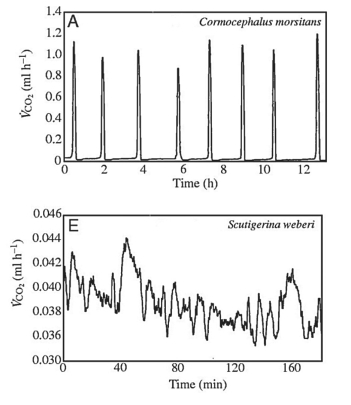Multiple Choice
Many terrestrial arthropods exchange gases with their environments by using tracheae, tubes that lead from openings (called spiracles) in the animal's exoskeleton or cuticle directly to the animal's tissues. Some arthropods can control whether their spiracles are opened or closed; opening the spiracles allows the carbon dioxide produced in the tissues to travel down the tracheae and be released outside the animal. Klok et al. measured the carbon dioxide emitted over time (represented by VCO₂) by several species of centipedes. Figure 33.2 presents graphs of their results for two species, Cormocephalus morsitans and Scutigerina weberi. (C. J. Klok, R. D. Mercer, and S. L. Chown. 2002. Discontinuous gas-exchange in centipedes and its convergent evolution in tracheated arthropods. Journal of Experimental Biology 205:1019-29.) Copyright (c) 2002, The Company of Biologists and the Journal of Experimental Biology.

Figure 33.2
-Look at the graph for Cormocephalus morsitans.What is the best interpretation of these results?
A) The centipede had its spiracles open the entire time.
B) The centipede had its spiracles closed the entire time.
C) The centipede had its spiracles open when CO₂ emission peaked and closed when CO₂ emission was low.
D) The centipede had its spiracles closed when CO₂ emission peaked and open when CO₂ emission was low.
Correct Answer:

Verified
Correct Answer:
Verified
Q2: Which of the following attributes is not
Q3: Which of these mollusc features substitutes for
Q3: What would be the most direct effect
Q4: The major evolutionary split of protostome animals
Q5: Suppose you were a researcher choosing a
Q6: Whiteflies are common pest insects found on
Q10: Among protostomes,which morphological trait has shown the
Q35: Figure 33.2<br>Use the following information when answering
Q36: As stated in the text, "DNA sequence
Q51: Use the following information to answer the